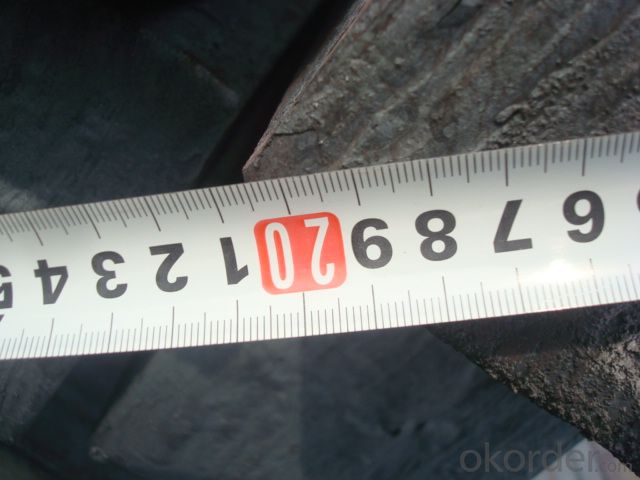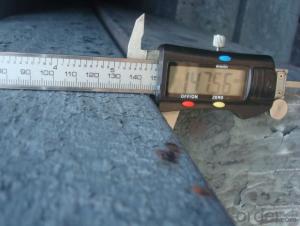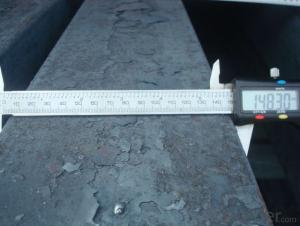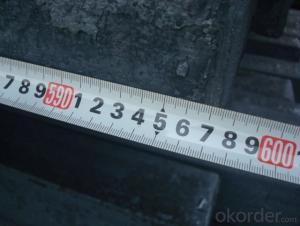Square Steel Billets 70mm 100mm 130mm 150mm 3SP
- Loading Port:
- Tianjin
- Payment Terms:
- TT OR LC
- Min Order Qty:
- 1000 m.t.
- Supply Capability:
- 30000 m.t./month
OKorder Service Pledge
OKorder Financial Service
You Might Also Like
STEEL BILLET
1.Brief description
Steel billet(ingot) by cogging or breakdown of semi-finished products, is the raw material of all kinds of steel mill. Billet section of square, round, flat, rectangular and abnormity of several kinds of, mainly related to the shape of rolled products.
2.Features
Rectangular billet continuous casting billet and mainly general carbon steel, low carbon low silicon cold-rolled material, high quality carbon structural steel, high strength low alloy steel, special steel, etc.
The billet is mainly divided into two kinds from the shape:
Slab: cross section width and height of the ratio of the larger, mainly used for rolling plate.
Billet: equal cross section width and height, or a huge difference, mainly used for rolling steel, wire rod. ,
Steel billets have distinct characteristics as compared with already furnished steel bars and products. Billets have a specific grain structure, which enables the metal to be processed more intricately. Steel billets are also known for their malleability and ductility, especially when exposed to varying temperatures during shaping and molding.
3.Processing
Steel billets are considered fresh and raw, and they must undergo a series of manufacturing processes before they can be used for various purposes. Billets are made by means of freezing molten liquid, and are later exposed to extremely low temperatures in order to allow the metal to take shape and solidify in chemical structure. The temperature manipulates the metal's physical properties, and tones its strength and durability. The subsequent processes provide the metal's curved mold design so that it can fit the allotted space provided by other machines, which complete the finishing procedures.
4.Pictures


5.Usage
Billets, or ingots (as they sometimes referred to), are not of practical use until they have been formed into more functional shapes and sizes. While they have already been put in the furnace, they still require a series of shaping and molding procedures such as hot and cold working, milling and cutting before they are sold in hardware stores, or used for different applications. The unformed billets, however, can be used in striking currency such as coins and as reserves, similar to gold bars.
6.Detailed specification
Hot rolled billet steel
Size: 50x50mm-180x180mm
Steel Grade: 3SP, 5SP,Q195,Q235,Q255,Q275 Length:3m-12m
MOQ: 1000MT/size
Payment term: TT or LC
Packing: in bulk , bundle
Shipment: by container , bulk vessel
Packaging Details: bundles with steel strips or as customers's requirements
Delivery time: 15-30 days after the deposit
Loading port:Tianjin, or other port China
Origin : China
Inspection:Third party inspection before loading.
- Q:What is the size range of steel billets?
- The size of steel billets can vary depending on the industry or application's specific requirements. Square or rectangular shapes are usually used to produce steel billets, with dimensions ranging from 100mm to 200mm in width and height. Additionally, the lengths can range from 3 to 12 meters. These dimensions can be customized according to the intended use of the billets, whether it be for forging, rolling, or further processing into finished steel products.
- Q:How do steel billets contribute to the manufacturing of furniture and fixtures?
- Steel billets are used in the manufacturing of furniture and fixtures as they serve as a raw material for various processes such as forging, casting, and extrusion. They can be shaped and molded into different components, such as frames, legs, and supports, which provide strength, durability, and stability to the furniture and fixtures. Additionally, steel billets can be further processed to create different finishes, such as powder coating or painting, to enhance the aesthetic appeal of the final products.
- Q:How do steel billets contribute to the food processing industry?
- Steel billets contribute to the food processing industry in several ways. Firstly, steel billets are used to manufacture various machinery and equipment used in the food processing industry. For example, they are used to create conveyor belts, mixers, crushers, and packaging machines, among others. These machines play a crucial role in the processing, handling, and packaging of food products. Steel billets are also used to produce storage tanks and containers, which are essential for the safe and hygienic storage of food ingredients and finished products. These tanks are usually made of stainless steel, which is corrosion-resistant, durable, and easy to clean, ensuring that the food remains uncontaminated and of high quality. Furthermore, steel billets contribute to the construction of infrastructure in the food processing industry. They are used to build food processing plants, warehouses, and cold storage facilities. These structures provide the necessary environment for food processing, such as temperature control and proper ventilation, ensuring food safety and preservation. Additionally, steel billets are crucial for the transportation of food products. They are used to manufacture shipping containers, refrigerated trucks, and railway cars, which enable the efficient and safe transportation of food from one location to another. The strength and durability of steel ensure that the food products are protected during transit, preventing spoilage and contamination. Overall, steel billets are essential in the food processing industry as they contribute to the manufacturing of machinery, storage containers, infrastructure, and transportation systems. Their properties of strength, durability, and corrosion resistance make them ideal for ensuring food safety, quality, and efficiency in all stages of food processing.
- Q:What is the difference between steel and billet in the process?
- Square is a square steel hollow, with iron produced; but it is a square steel billet is generally solid, forging or casting molding.
- Q:How are steel billets tested for strength and durability?
- Steel billets are tested for strength and durability through a series of rigorous examinations and tests. The main objective is to ensure that the billets possess the necessary properties to withstand the intended application and perform optimally under various conditions. One of the key tests conducted on steel billets is the tensile strength test. This test involves subjecting the billet to a gradually increasing axial load until it reaches its breaking point. By measuring the applied force and the resulting deformation, the ultimate tensile strength of the billet can be determined. This test assesses the ability of the steel to resist external forces and provides crucial information about its structural integrity. Another important evaluation is the hardness test. This test measures the resistance of the steel billet to indentation or scratching. Various methods, such as the Brinell, Rockwell, or Vickers hardness tests, can be employed to determine the hardness value. This information aids in assessing the billet's resistance to wear, deformation, and potential damage. Heat treatment is also an essential process in testing the strength and durability of steel billets. Heat treatment involves subjecting the billets to controlled heating and cooling cycles to modify their microstructure, resulting in improved mechanical properties. By carefully monitoring the temperature, time, and cooling rate during heat treatment, the desired properties, such as increased strength and toughness, can be achieved. Additionally, non-destructive testing techniques, such as ultrasonic testing, magnetic particle inspection, and radiographic examination, are employed to assess the internal quality and identify any potential defects or flaws in the billets. These methods provide valuable information about the billet's structural soundness, ensuring it meets the required standards and specifications. Furthermore, chemical composition analysis is conducted to verify the elemental composition of the steel billets. This analysis ensures that the alloying elements are present within the specified limits, as they greatly influence the billet's mechanical properties. Any deviation from the required composition could lead to compromised strength and durability. Overall, steel billets undergo a comprehensive series of tests and evaluations to ensure their strength and durability. These examinations include tensile strength testing, hardness testing, heat treatment, non-destructive testing, and chemical composition analysis. By subjecting the billets to these assessments, manufacturers can guarantee the quality of their steel products, ensuring they meet the demanding requirements of various applications.
- Q:How are steel billets used in the manufacturing of medical devices?
- The manufacturing of medical devices relies on steel billets in multiple ways. Surgical instruments, like scalpels, forceps, and scissors, use steel billets as a raw material. These instruments demand strength, durability, and corrosion resistance, qualities that steel billets possess. Steel billets also find use in the production of implants, such as joint replacements and dental implants. These implants must withstand the body's load and stress, making steel billets an ideal material due to their outstanding mechanical properties. Furthermore, medical equipment like hospital beds, wheelchairs, and surgical tables are manufactured using steel billets. These devices require a robust structure, and steel billets provide the necessary strength and stability. Moreover, steel billets are integral to the manufacturing of medical equipment components, such as brackets, frames, and supports. These components are crucial for the proper functioning and stability of medical devices, and steel billets are often selected for their high machinability and weldability. In summary, steel billets play a vital role as a raw material in the manufacturing of diverse medical devices. Their strength, durability, corrosion resistance, and other mechanical properties make them an excellent choice for producing surgical instruments, implants, medical equipment, and their components.
- Q:What are the different types of forging processes used for shaping steel billets?
- There are several types of forging processes used for shaping steel billets. Some common ones include open-die forging, closed-die forging, impression-die forging, and seamless rolled ring forging. Each process has its unique characteristics and is suitable for specific applications.
- Q:How do steel billets contribute to the manufacturing of medical equipment?
- The manufacturing of medical equipment is greatly aided by steel billets. Various components of medical equipment are produced using steel billets as the raw material. These billets are melted and then formed into tubes, rods, or sheets, which are subsequently utilized to create essential parts of medical equipment. For example, scalpels, forceps, and scissors, which require precision and durability, are commonly manufactured using steel billets. Steel's strength and resistance to corrosion make it the ideal material for these instruments. By melting and shaping steel billets into specific forms, the reliability and longevity of these instruments are ensured. Furthermore, medical implants such as hip replacements, knee replacements, and dental implants require materials that are biocompatible, strong, and resistant to wear. Steel billets, especially stainless steel, fulfill these requirements and are employed in the creation of implants that enhance the quality of life for many patients. In addition, steel billets contribute to the manufacturing of medical equipment by providing the framework for devices like hospital beds, surgical tables, and examination tables. These structures need to be sturdy, stable, and capable of supporting the weight of patients. Steel billets are transformed into various shapes and sizes to construct the frames and bases of these equipment, ensuring their robustness and reliability. To summarize, steel billets play a vital role in the manufacturing of medical equipment. They serve as the raw material, which is melted, shaped, and converted into components, instruments, and structures necessary for the production of surgical instruments, implants, and medical devices. The strength, durability, and corrosion resistance of steel make it an ideal material for manufacturing medical equipment that meets the stringent standards of the healthcare industry.
- Q:How do steel billets contribute to the automotive industry?
- Steel billets play a crucial role in the automotive industry by serving as the primary raw material for the production of various automotive components. These components include engine parts, transmission systems, chassis, suspension systems, and other critical components that ensure the safety, performance, and durability of vehicles. One of the key contributions of steel billets to the automotive industry is their exceptional strength and durability. Steel is renowned for its high tensile strength, which allows it to withstand extreme forces and provide structural integrity to automotive components. This strength is particularly important in areas such as the frame, where it ensures the safety of passengers in the event of a collision. Additionally, steel billets offer excellent formability and versatility, allowing manufacturers to create intricate and complex automotive parts with precision. This enables the production of components that meet the specific design requirements of different vehicle models, ensuring optimal performance and functionality. Steel billets also contribute to the automotive industry by providing cost-effectiveness. Steel is a relatively affordable material compared to alternatives such as aluminum or carbon fiber. Its widespread availability and production efficiency make it a cost-effective choice for mass production, helping to keep vehicle prices reasonable for consumers. Moreover, steel billets possess excellent heat resistance and thermal conductivity properties. This makes them ideal for use in engine components, such as pistons and cylinder heads, where they can withstand high temperatures and efficiently transfer heat. Furthermore, steel billets contribute to the sustainability of the automotive industry. Steel is a highly recyclable material, with a recycling rate of around 90%. This allows for the eco-friendly disposal and reuse of steel components, reducing the environmental impact of the automotive manufacturing process. In summary, steel billets play a vital role in the automotive industry by providing the strength, durability, formability, and cost-effectiveness necessary for the production of various automotive components. Their versatility and recyclability further contribute to the sustainability of the industry. Without steel billets, the automotive industry would struggle to produce safe, reliable, and affordable vehicles.
- Q:What are the different types of steel billet machining processes?
- In the industry, various steel billet machining processes are utilized. Among the most commonly employed methods are as follows: 1. Turning: By rotating the steel billet against a cutting tool, material is removed and the desired shape is achieved. This method is typically used for creating cylindrical or conical shapes. 2. Milling: Material is removed from the steel billet using a rotating multi-point cutting tool. This versatile process can be employed to fashion a range of shapes, including flat surfaces, slots, and grooves. 3. Drilling: Holes are created in the steel billet by employing a rotating drill bit. This can be done manually or through automated machines, and is often utilized to create holes for fasteners such as bolts or screws. 4. Grinding: An abrasive wheel is employed to remove material from the surface of the steel billet. This process is frequently used to achieve a smooth and precise finish or eliminate any undesired surface imperfections. 5. Sawing: The steel billet is cut using a saw blade, which can be of various types such as band saws, circular saws, or abrasive saws. Sawing is often employed to divide the billet into smaller pieces or remove excess material. 6. Broaching: Utilizing a specialized cutting tool named a broach, material is removed from the steel billet. This method is frequently applied to create internal or external features such as keyways or splines. 7. Honing: A finishing process involving the use of abrasive stones to create a smooth and precise surface on the steel billet. Honing is often employed to enhance dimensional accuracy, surface finish, and overall quality of the billet. These examples represent only a few of the diverse steel billet machining processes available. The selection of a particular process depends on the specific requirements of the project, including the desired shape, size, and surface finish of the steel billet.
1. Manufacturer Overview |
|
|---|---|
| Location | |
| Year Established | |
| Annual Output Value | |
| Main Markets | |
| Company Certifications | |
2. Manufacturer Certificates |
|
|---|---|
| a) Certification Name | |
| Range | |
| Reference | |
| Validity Period | |
3. Manufacturer Capability |
|
|---|---|
| a)Trade Capacity | |
| Nearest Port | |
| Export Percentage | |
| No.of Employees in Trade Department | |
| Language Spoken: | |
| b)Factory Information | |
| Factory Size: | |
| No. of Production Lines | |
| Contract Manufacturing | |
| Product Price Range | |
Send your message to us
Square Steel Billets 70mm 100mm 130mm 150mm 3SP
- Loading Port:
- Tianjin
- Payment Terms:
- TT OR LC
- Min Order Qty:
- 1000 m.t.
- Supply Capability:
- 30000 m.t./month
OKorder Service Pledge
OKorder Financial Service
Similar products
New products
Hot products
Related keywords






























